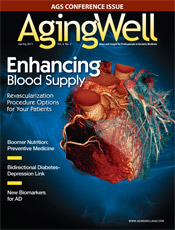
Spring 2011
Seizures in Older AdultsBy Jaimie Lazare Often described as body stiffening, falling, and jerking movements accompanied by a loss of consciousness, seizures typically present in this manner and are generally classified as tonic-clonic seizures (grand mal seizures). Yet these electrical disturbances in the brain vary significantly, with presentations differing among age groups. According to the Epilepsy Foundation, more than 570,000 people aged 65 and older have epilepsy, and older adults are the fastest growing population to be affected by the disease. Jacqueline A. French, MD, a neurologist at the New York University Comprehensive Epilepsy Center and member of the American Academy of Neurology, says there are two peak periods during which the onset of epilepsy is most likely: one occurs in childhood and the other after the age of 65. As French explains, when parents observe their children having seizures, it’s a life-changing event and they are more public about it. But when individuals develop seizures as older adults, they are less likely to be open about it because the disease is poorly understood and carries a stigma, making it a hidden disease for many older adults. Tina T. Shih, MD, a neurologist at the University of California-San Francisco Epilepsy Center in San Francisco, says, “We don’t know the full breadth of the different possible presentations or classifications of epilepsy.” Among those in the field of neurology, the preconceived notion is that older patients are having focal seizures, coming from one area of the brain, and they can have different manifestations that include staring, brief unresponsiveness, lip smacking, language difficulties, and confusion. Seizures among older adults can be attributed to myriad conditions that affect the brain; the Epilepsy Foundation states that seizures are associated with physical changes in an elder’s brain caused by a stroke, heart disease, Alzheimer’s disease, or brain tumors. However, French says that in at least one half of the elder patients who develop epilepsy the etiology is cryptogenic, meaning the origin or cause hasn’t been identified. Although various factors can increase the risk of developing seizures, they sometimes occur in the absence of any known risks. “In the epilepsy world, we feel strongly that people who develop epilepsy over the age of 65 have a structural brain abnormality and most of their epilepsy is focal in onset,” French says. “So there’s just one single area of the brain that is affected and is electrically unstable, which makes us believe that something happened to that piece of brain and that’s why we call it cryptogenic, meaning there is a cause [but] we just aren’t smart enough to know what it is.” Elusive Diagnosis The key to identifying seizures in older adults is determining whether there are stereotyped behaviors or movements occurring and noting the duration of the episodes. “Ninety percent of seizures last anywhere between seconds up to three minutes; the seizure itself usually doesn’t last longer than three minutes,” French says. The postictal phase, the period following a seizure or convulsion, can last longer because the brain is exhausted, leading to prolonged periods of confusion or sleepiness. A thorough patient history is extremely helpful in diagnosing seizures, and family members and caregivers play a crucial role in assisting practitioners in collecting this vital data. Of particular concern is the limited time allotted for physicians to conduct detailed histories. “In today’s reimbursement world, that thinking part of the physician evaluation doesn’t reimburse very well. Primary care doctors are not allowed a lot of time and you can’t get that history in that short period of time, and often the patient isn’t accompanied by the person who witnessed the event,” Shih says. French agrees that patient history is crucial and if seizures are suspected in older adults, the next step would be to perform an electroencephalogram (EEG) to record the patient’s brain waves. However, EEGs may yield nondiagnostic findings in a patient who experiences seizures. In such cases, physicians may consider inpatient video EEG monitoring, which is considered the gold standard for diagnosis. The postdiagnostic challenge for practitioners treating seizures in older adults is prescribing an antiepileptic drug (AED) that can control seizures and be well tolerated by a patient. Medication Therapies While first-generation AEDs (eg, phenytoin, carbamazepine) are commonly prescribed, they produce a sedating effect. And although such drugs are not particularly problematic for younger patients, they may cause gait instability or memory problems for older adults, French says. She emphasizes the importance of recognizing drug interactions. First-generation AEDs may induce the hepatic metabolism of nonepilepsy drugs, resulting in the increased removal or clearance of other drugs an older adult takes. Studies have shown that second-generation AEDs such as gabapentin and lamotrigine are better tolerated and do not cause the drug interactions seen in first-generation AEDs. However, these newer drugs are more expensive. Concerning cost, French advises prescribing the AED with the fewest drug interactions rather than worrying about readjusting the dosage of other more expensive medications that may be affected by an AED. Regardless of a patient’s age, discussing safety concerns related to epilepsy is an important part of patient care. While state regulations vary regarding the suspension of a seizure patient’s driving privilege, there are other activities that should be discussed with patients and their caregivers. Shih recommends that older adults with epilepsy be advised not to take baths without someone to check on their safety because a lapse in consciousness in even a few inches of water may lead to drowning. Swimming alone, climbing ladders, and operating heavy machinery are just a few activities that carry dangerous risks for seizure patients. Because older adults are living longer and are expected to remain active later in their lives, adjusting to an epilepsy diagnosis warrants numerous considerations. But when it comes to restructuring elders’ lives around the disease, Shih says, providers can promote a balance between staying active and independent while maintaining an awareness of personal and public safety measures. — Jaimie Lazare is a freelance writer based in Brooklyn, N.Y.
|
